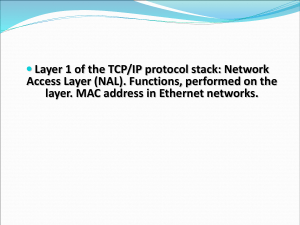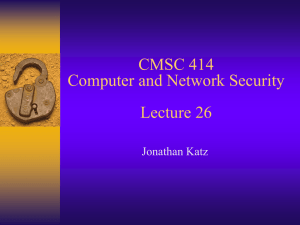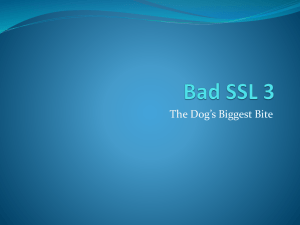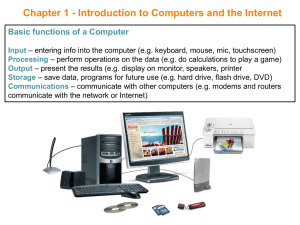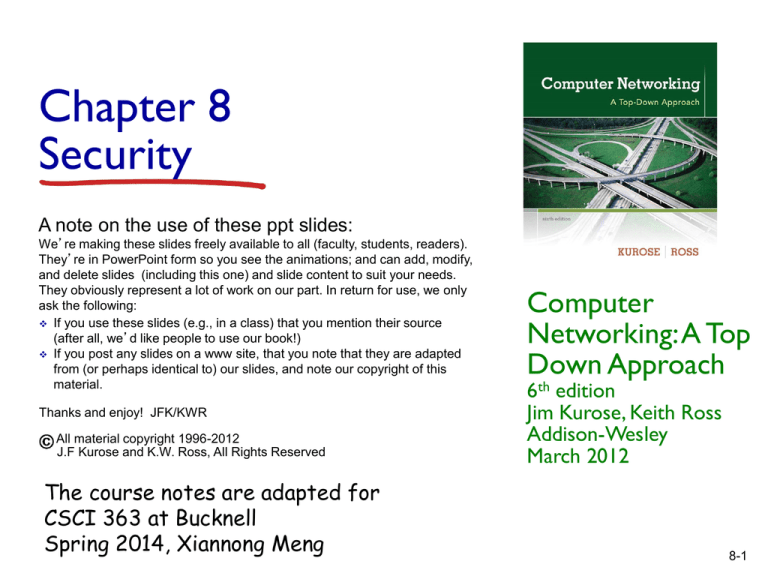
Chapter 8
Security
A note on the use of these ppt slides:
We’re making these slides freely available to all (faculty, students, readers).
They’re in PowerPoint form so you see the animations; and can add, modify,
and delete slides (including this one) and slide content to suit your needs.
They obviously represent a lot of work on our part. In return for use, we only
ask the following:
If you use these slides (e.g., in a class) that you mention their source
(after all, we’d like people to use our book!)
If you post any slides on a www site, that you note that they are adapted
from (or perhaps identical to) our slides, and note our copyright of this
material.
Thanks and enjoy! JFK/KWR
All material copyright 1996-2012
J.F Kurose and K.W. Ross, All Rights Reserved
The course notes are adapted for
CSCI 363 at Bucknell
Spring 2014, Xiannong Meng
Computer
Networking: A Top
Down Approach
6th edition
Jim Kurose, Keith Ross
Addison-Wesley
March 2012
8-1
Chapter 8 roadmap
8.1 What is network security?
8.2 Principles of cryptography
8.3 Message integrity
8.4 Securing e-mail
8.5 Securing TCP connections: SSL
8.6 Network layer security: IPsec
8.7 Securing wireless LANs
8.8 Operational security: firewalls and IDS
Network Security
8-2
SSL: Secure Sockets Layer
widely
deployed security
protocol
original
goals:
Web e-commerce
supported by almost all
transactions
browsers, web servers
encryption (especially
https
credit-card numbers)
billions $/year over SSL
Web-server authentication
mechanisms: [Woo 1994],
optional client
implementation: Netscape
authentication
variation -TLS: transport layer
minimum hassle in doing
business with new
security, RFC 2246 (1999)
merchant
provides
available to all TCP
confidentiality
applications
integrity
secure socket interface
authentication
Network Security
8-3
SSL and TCP/IP
Application
Application
SSL
TCP
IP
normal application
TCP
IP
application with SSL
SSL provides application programming interface
(API) to applications
C and Java SSL libraries/classes readily available
Network Security
8-4
Could do something like PGP:
-
KA
m
.
H( )
-
.
KA( )
-
KA(H(m))
+
KS
.
KS( )
+
m
KS
+
.
KB( )
+
Internet
+
KB(KS )
KB
but want to send byte streams & interactive data
want set of secret keys for entire connection
want certificate exchange as part of protocol: handshake phase
Network Security
8-5
https://en.wikipedia.org/wiki/File:PGP_diagram.svg
PGP: Pretty Good Privacy
8-6
Network Security
Toy SSL: a simple secure channel
handshake: Alice and Bob use their certificates,
private keys to authenticate each other and
exchange shared secret
key derivation: Alice and Bob use shared secret to
derive set of keys
data transfer: data to be transferred is broken up
into series of records
connection closure: special messages to securely
close connection
Network Security
8-7
Toy: a simple handshake
MS: master secret
EMS: encrypted master secret
Network Security
8-8
Toy: key derivation
considered bad to use same key for more than one
cryptographic operation
use different keys for Message Authentication Code (MAC) and
encryption
four keys:
Kc = encryption key for data sent from client to server
Mc = MAC key for data sent from client to server
Ks = encryption key for data sent from server to client
Ms = MAC key for data sent from server to client
keys derived from key derivation function (KDF)
takes master secret and (possibly) some additional random data
and creates the keys
Network Security
8-9
Toy: data records
why not encrypt data in constant stream as we write it to
TCP?
where would we put the MAC? If at end, no message integrity
until all data processed.
e.g., with instant messaging, how can we do integrity check over
all bytes sent before displaying?
instead, break stream in series of records
each record carries a MAC
receiver can act on each record as it arrives
issue: in record, receiver needs to distinguish MAC from
data
want to use variable-length records
length
data
MAC
Network Security
8-10
Toy: sequence numbers
problem: attacker can capture and replay record
or re-order records
solution: put sequence number into MAC:
MAC = MAC(Mx, sequence||data)
note: no sequence number field
problem: attacker could replay all records
solution: use nonce
Network Security
8-11
Toy: control information
problem: truncation attack:
attacker forges TCP connection close segment
one or both sides thinks there is less data than there
actually is.
solution: record types, with one type for closure
type 0 for data; type 1 for closure
MAC = MAC(Mx, sequence||type||data)
length
type
data
MAC
Network Security
8-12
Toy SSL: summary
encrypted
bob.com
Network Security
8-13
Toy SSL isn’t complete
how long are fields?
which encryption protocols?
want negotiation?
allow client and server to support different
encryption algorithms
allow client and server to choose together specific
algorithm before data transfer
Network Security
8-14
SSL cipher suite
cipher suite
public-key algorithm
symmetric encryption algorithm
MAC algorithm
common SSL symmetric
ciphers
DES – Data Encryption
Standard: block
3DES – Triple strength: block
RC2 – Rivest Cipher 2: block
RC4 – Rivest Cipher 4:
stream
SSL supports several cipher
suites
negotiation: client, server
agree on cipher suite
SSL Public key encryption
client offers choice
server picks one
RSA
Network Security
8-15
Real SSL: handshake (1)
Purpose
1. server authentication
2. negotiation: agree on crypto algorithms
3. establish keys
4. client authentication (optional)
Network Security
8-16
Real SSL: handshake (2)
1.
2.
3.
4.
5.
6.
client sends list of algorithms it supports, along with
client nonce
server chooses algorithms from list; sends back:
choice + certificate + server nonce
client verifies certificate, extracts server’s public
key, generates pre_master_secret, encrypts with
server’s public key, sends to server
client and server independently compute encryption
and MAC keys from pre_master_secret and nonces
client sends a MAC of all the handshake messages
server sends a MAC of all the handshake messages
Network Security
8-17
Real SSL: handshaking (3)
last 2 steps protect handshake from tampering
client typically offers range of algorithms, some
strong, some weak
person-in-the middle could delete stronger
algorithms from list
last 2 steps prevent this
last two messages are encrypted
Network Security
8-18
Real SSL: handshaking (4)
why two random nonces (one for server and one
for client) in a session?
suppose Trudy sniffs all messages between Alice
& Bob
next day, Trudy sets up TCP connection with
Bob, sends exact same sequence of records
Bob (Amazon) thinks Alice made two separate orders
for the same thing
solution: Bob sends different random nonce for each
connection. This causes encryption keys to be different
on the two days
Trudy’s messages will fail Bob’s integrity check
Network Security
8-19
SSL record protocol
data
data
fragment
record
header
data
fragment
MAC
encrypted
data and MAC
record
header
MAC
encrypted
data and MAC
record header: content type; version; length
MAC: includes sequence number, MAC key Mx
fragment: each SSL fragment 214 bytes (~16 Kbytes)
Network Security
8-20
SSL record format
1 byte
2 bytes(major/minor)
content
SSL version
type
2 bytes
length
data
MAC
data and MAC encrypted (symmetric algorithm)
MAC length is variable depending on the chosen algorithm,
e.g., MD5: 128 bits MAC, SHA1: 160 bits MAC
Network Security
8-21
Real SSL
connection
everything
henceforth
is encrypted
TCP FIN follows
Network Security
8-22


